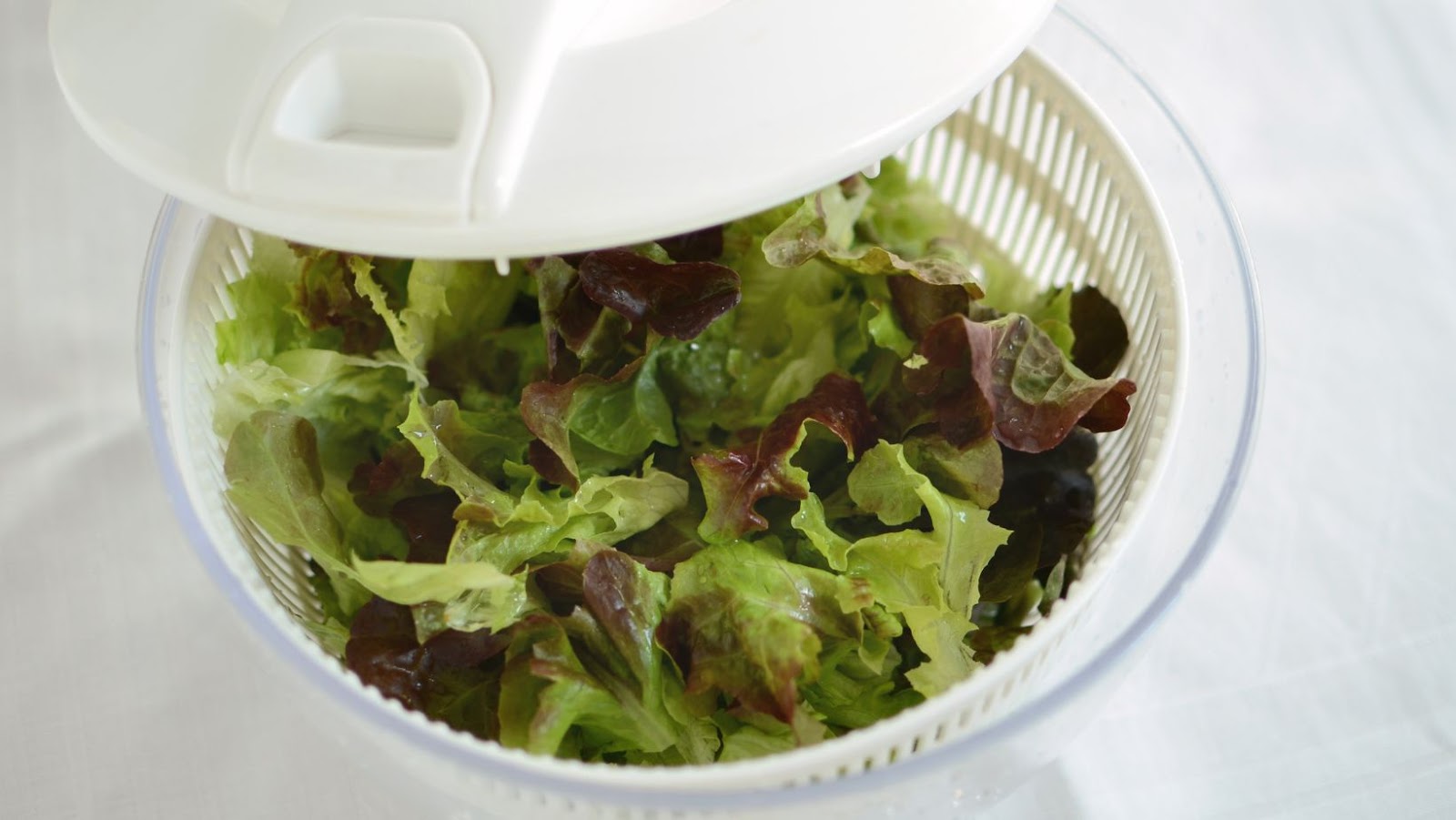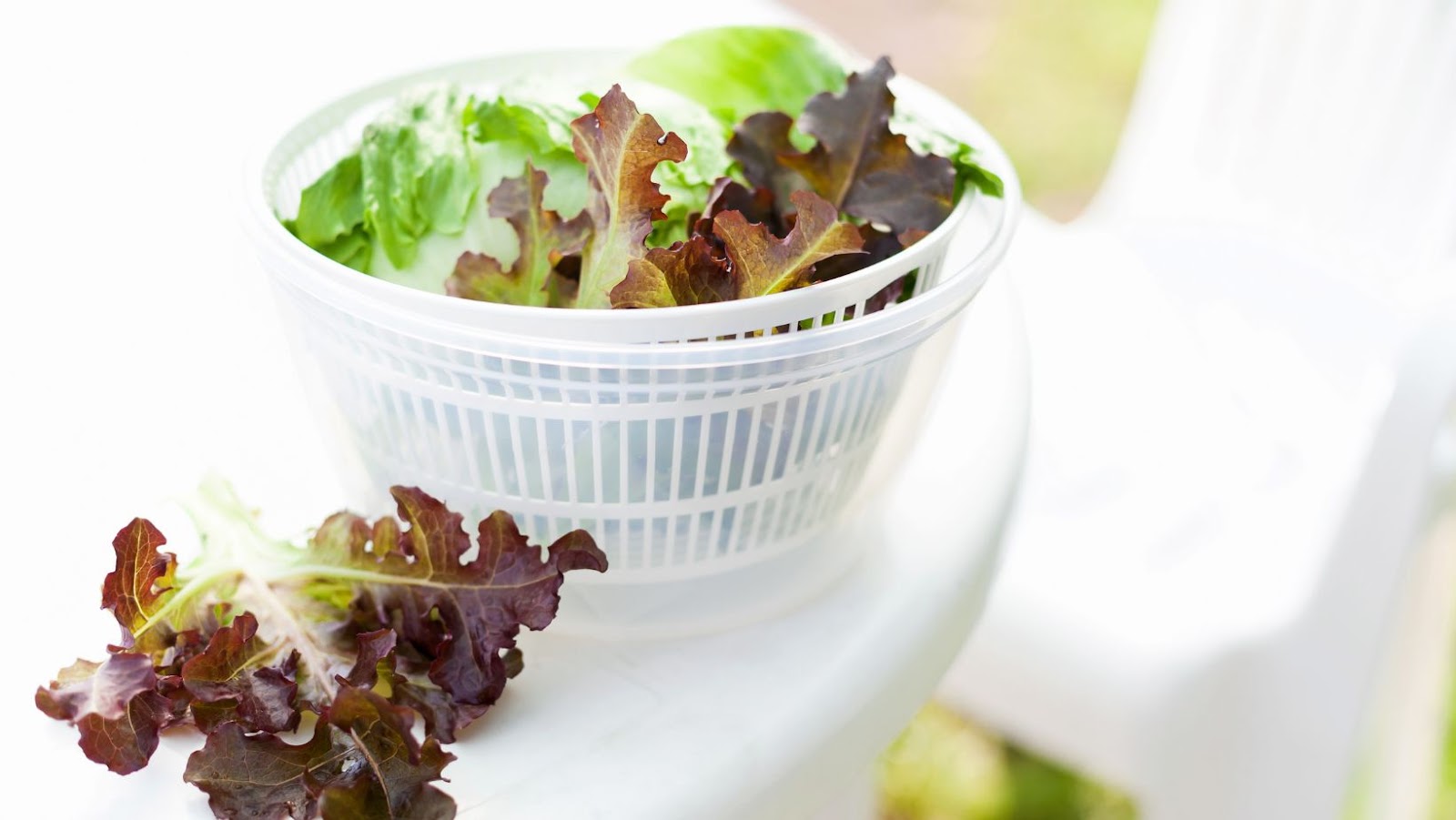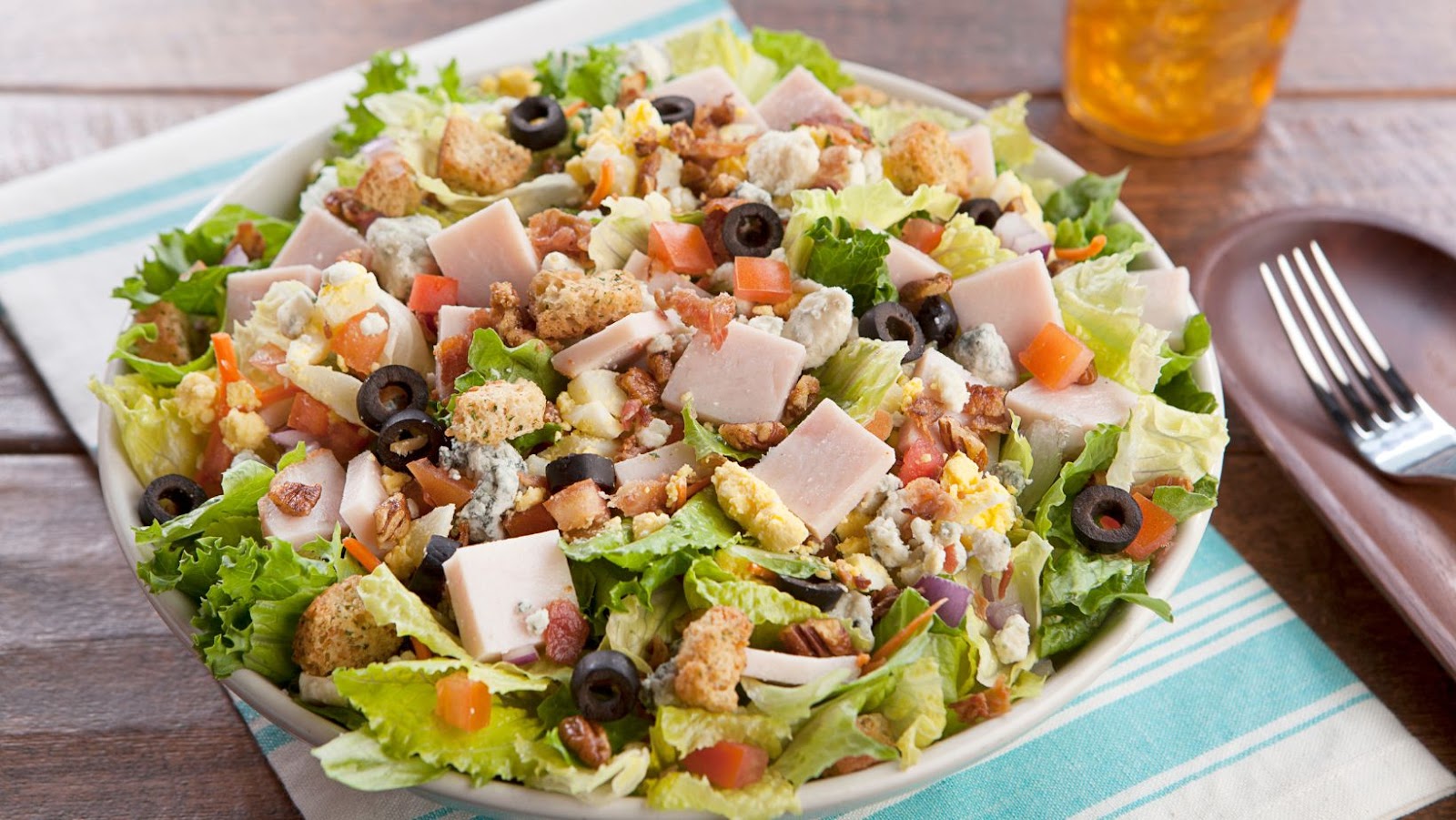
The Best Salad Spinners On The Market
Salad spinners are all the rage these days, and for good reason. With so many options on the market, it can be tough to know which one to pick. Here’s an overview of some top salad spinners and what makes them stand out:
| Brand | Capacity | Material | Special features |
| OXO Good Grips | 5 quarts | BPA-free plastic and stainless steel | Easy pump mechanism, non-slip base, clear lid with lockable lever |
| Mueller Austria Pro Series | 5 quarts | BPA-free plastic and stainless steel | Durable construction, non-slip base, compact design for easy storage |
| Cuisinart Salad Spinner | 5 quarts/7 quarts | BPA-free plastic bowl with stainless steel basket/plastic bowl | Any features often found in multiple columns |
It’s important to consider capacity, material, and special features when selecting a salad spinner. However, don’t forget about ease of use! Look for a spinner with simple instructions so you can spend less time figuring it out and more time enjoying your delicious salads.
Pro Tip: Don’t overload your spinner – it will work better if you spin smaller batches.
Choosing a salad spinner is like choosing a life partner – make sure it’s reliable, efficient, and doesn’t leave any soggy mess in the end.
Features to Consider When Choosing a Salad Spinner
To choose the best salad spinner for your kitchen, consider the features of the spinner that match your needs. With our guide on the features to consider when choosing a salad spinner with material and durability, capacity, ease of use, cleaning and maintenance, and extras such as multiple functions or non-slip base, you can find the perfect spinner to meet your specific requirements.
Material and Durability
When selecting a tool to quickly dry and clean your greens, it is essential to take into consideration the materials used to make the spinner as well as its durability. The design and strength of the device determine the quality of performance. Below is a table highlighting the different types of materials commonly used in salad spinners, their pros, cons, and durability:
| Material | Pros | Cons | Durability |
| Plastic | Lightweight, affordable | Can scratch or crack over time | Average |
| Stainless Steel | Durable, sturdy, long-lasting | More expensive than other materials | Excellent |
| Glass/Pyrex | Non-toxic, eco-friendly | Breakable if dropped or knocked | Good |
In addition to material and durability considerations when choosing a salad spinner, there are unique features that you should also keep in mind. These aspects include capacity size, ease of use/cleaning, speed at which it spins leaves dry. Each feature plays an important part in giving you the best experience with a salad spinner. Interestingly enough, Salad spinners originated from a French invention called “cleaner-dryer,” patented in 1936 by Marc Marseille. However, It wasn’t until the 1970s that they gained popularity in America among home cooks and professional chefs alike. With a salad spinner that can handle enough greens to feed a rabbit colony, you’ll never have to suffer through soggy salads again.
Capacity
When choosing a salad spinner, it’s essential to consider the amount of produce you’ll need to spin dry at once. This aspect is crucial as it determines whether a specific salad spinner is suitable for your needs.
Below is a table showcasing the Capacity of various Salad Spinners:
| Salad Spinner | Capacity (in liters) |
| OXO Good Grips Salad Spinner | 4.7 |
| Prepworks by Progressive Salad Spinner | 4.5 |
| Zyliss Easy Spin Salad Spinner | 4 |
Aside from capacity, some salad spinners offer additional features such as non-slip bases or colanders that can double up as strainers.
Pro Tip: When choosing a salad spinner, choose one with at least two to three liters of capacity to ensure that you can spin dry enough greens in one go while still being able to store it conveniently in your kitchen.
Using this salad spinner is easier than getting a cat to take a bath (trust me, I’ve tried).

Ease of Use
When choosing a Salad Spinner, usability plays a crucial role in the decision-making process. A user-friendly feature set ensures quick and effortless operation, saving time and effort while prepping your greens. The ease with which you can add or remove parts for cleaning is also important.
It’s better to choose a Salad Spinner that compliments your kitchen space with its compact and lightweight design for ease of storage. An ergonomic handle allows for comfortable grip while spinning, keeping the veggies crisp without bruising or damaging them. Versatility in the size of salad mixers allows users to spin different amounts as per their requirement.
One unique feature to look out for when considering usability is how much water the spinner removes from greens after washing them properly; some spinners are better at extracting excess moisture than others. Additionally, pay attention to the build quality of the appliances – whether they’re made of sturdy materials and won’t break down easily.
In 1974, an engineering student named Ellis Williams invented the first salad spinner after watching his father struggle to dry lettuce by hand. His creation quickly gained popularity as an essential tool for any home cook or professional chef alike due to its efficiency in cleaning leafy greens without causing any damage whatsoever! Cleaning your salad spinner is like cleaning a relationship – if you neglect it for too long, it’ll start to stink.
Cleaning and Maintenance
When it comes to keeping your salad spinner in tip-top shape, there are some crucial details to consider. Proper care and maintenance of your kitchen equipment can go a long way in extending its lifespan and ensuring it remains effective. Here’s a quick guide on how to clean and maintain your salad spinner.
- Disassemble the parts – Remove all detachable parts such as the basket and lid.
- Hand wash or use a dishwasher – Either hand wash the parts with soap or put them in the dishwasher.
- Scrub away any residue – Use a brush or sponge to get rid of any stubborn debris or food particles, paying special attention to hard-to-reach corners.
- Towel dry – After washing, use a towel to dry all parts thoroughly before storing them away.
- Store properly – Avoid keeping the salad spinner in damp areas, and always reassemble it before storing it away.
- Regularly check for wear and tear – Over time, the spinning mechanism may become loose or break, resulting in poor performance. Check regularly for signs of damage.
In addition, be sure to avoid using abrasive cleaners or scouring pads that can damage your salad spinner’s surface. By following these steps, you’ll ensure that your salad spinner stays in top condition for years to come.
Lastly, make sure to keep an eye out for any cracks or leaks that could compromise the effectiveness of your salad spinner. Consider investing in higher-quality spinners with metal gears for increased durability and longevity.
Because who wouldn’t want a salad spinner that can also moonlight as a DJ or a personal masseuse?
Extras (Such as Multiple Functions or Non-Slip Base)
Salad Spinners with Additional Features
A salad spinner can serve many functions apart from gently drying your greens. When choosing a salad spinner, you may want to consider additional features that improve functionality and convenience.
Below are some examples of additional features that may be available on modern salad spinners:
| Feature | Description |
| Non-Slip Base | A rubberized or silicone base keeps the spinner secure on any surface while in use. |
| Multiple Functions | In addition to being a salad spinner, some models come with attachments for slicing, dicing or grating vegetables and fruits. |
| Huge Capacity | Salad spinners sometimes come in larger versions that are useful for washing and drying bigger portions for entire families. |

In your search for a salad spinner, it’s worth noting that there are also models that come equipped with collapsible parts, which make storage more convenient. Additionally, you may want to check if the spinner is dishwasher-safe, as this can save time during cleaning.
Pro Tip – If you’re looking for a highly versatile model – go for one with multiple functions. This way, you can save some space in your kitchen while still benefiting from several kitchen gadgets at once.
Spin it right round, baby, right round – tips for getting the most out of your salad spinner!
How to Use Salad Spinner
To properly use a salad spinner with washing and preparing greens, assembling the spinner, drying the greens, and removing any remaining moisture, we’ve got you covered. Each of these steps is essential in getting the best out of your salad spinner.
Washing and Preparing Greens
When it comes to preparing your greens, you want to ensure that they are clean and ready for consumption. Here’s a quick guide on how to properly wash and prepare your greens for a delicious salad.
- Start by filling a bowl with cool water.
- Next, pour the greens into the bowl and swish them around gently with your hands.
- Remove the greens from the water and place them into a salad spinner.
- Spin the greens until all excess water has been removed.
By properly washing and preparing your greens, you not only remove any dirt or debris but also ensure that they are crisp and refreshing in your salad. To add an extra element of freshness to your salad, consider adding herbs like basil or cilantro before serving.
Did you know that the first salad spinner was patented in 1972 by George Sanna? He initially created it to dry clothes faster, but later discovered its usefulness in drying lettuce as well. Assembling the Salad Spinner: because getting it together is easier than trying to spin lettuce by hand.
Assembling the Spinner
To put together your salad spinner, follow these steps:
- Place the bowl of the spinner upside-down on a flat surface.
- Insert the interior basket into the bowl.
- Place the lid on top of the bowl and snap it in place.
- Twist the handle onto the top of the lid until it clicks into place.
- Finally, give your spinner a test spin to ensure that everything is secure and functioning properly.
It’s essential to ensure that your salad spinner is assembled accurately, or you won’t be able to use it correctly. To emphasize, twist each piece together firmly before moving onto the next step. Doing so will prevent leaks and guarantee that your greens are efficiently dried.
Suppose you’re struggling with assembling any part of your salad spinner; many tutorials cover this topic, providing additional help. There are even YouTube videos readily available that guide users through each step in detail.
For best results, remember to cut off any wilted or brown leaves from your greens before putting them in your salad spinner. Additionally, there are many variations in size when it comes to these kitchen gadgets; thus, shop around for what works best for your needs.
Spin it like you mean it, or else your greens will be soggy and unclean.
Drying the Greens
After washing your greens, it’s essential to remove as much water as possible using a Salad Spinner. Ensuring the greens are thoroughly dry prevents wilting and helps the salad dressings coat every leaf evenly.
Here is a five-step guide for properly drying the greens:
- After washing, place the greens in the basket of the Salad Spinner.
- Spin at high speed to remove excess water. Make sure to apply enough pressure to release any trapped water.
- Without removing the lid, give the Spinner a few extra pumps to extract any remaining moisture.
- Lift out the basket, and discard any accumulated water from the outer bowl.
- Gently pat dry any leftover droplets on individual leaves with a clean cloth or paper towel.
Using this method will ensure that your salads look and taste their best, without sacrificing flavor or freshness. It’s important to note that over-drying can lead to damaged leaves and limp salads, so always pay attention when spinning your greens.
Interestingly, food scientist Joel Miller invented the original Salad Spinner in 1974 while working at Purdue University’s Department of Food Science. His goal was to create an alternative way for households to dry fresh produce without using paper towels or dishcloths. Today it remains an innovative tool in every kitchen!
Say goodbye to soggy salads and hello to crisp greens with this simple tip for removing any remaining moisture – just spin, spin, spin!
Removing Any Remaining Moisture
- To ensure your salad is as dry as possible, follow these steps.
- First, carefully place the washed greens in the salad spinner bowl.
- Next, secure the lid and turn the crank handle to start spinning.
- Third, stop the spinner and check for any remaining moisture on the leaves.
- Fourth, remove any excess water by gently dabbing a paper towel on them.
- Fifth, spin the greens again to ensure all water has been removed.
- Finally, transfer your dried greens to a large bowl or storage container.
It’s important to note that some vegetables may require multiple spins in order to fully remove all of the water from their leaves. Take care not to crush delicate herbs or greens during this process.
Pro Tip: For extra-dry greens, place a layer of paper towels at the bottom of your salad spinner before adding your washed vegetables.
Spin your way to a cleaner, crisper salad with the magical powers of a salad spinner.

Benefits of Using a Salad Spinner
To get the best out of your salads, you must use a salad spinner. With the benefits of preventing soggy salads, saving time, and being easy to store and use, you can achieve a crisp and fresh salad in seconds. Moreover, a salad spinner isn’t just limited to salads, but can also be used for other foods.
Prevents Soggy Salads
Using a salad spinner not only ensures that your greens remain dry and crunchy but also helps to retain their freshness and nutrients. To avoid a soggy mess in your salads, consider using this handy kitchen tool.
Here’s a simple 3-step guide to prevent soggy salads:
- Wash the greens thoroughly under cold water.
- Add the washed greens to the basket of the salad spinner.
- Spin the basket at high speed until all excess water has been extracted from the greens.
In addition, using a salad spinner can also save you time and effort as it eliminates the need for paper towels or air-drying. This tool is a must-have for salad lovers who want to enjoy fresh and crispy greens daily. According to a study by Consumer Reports, using a salad spinner was found to be more effective in removing excess moisture from lettuce compared to other methods like shaking or blotting with paper towels.
So why settle for soggy salads when you can easily prevent them with this simple yet effective kitchen gadget? Give it a try and see how much difference it makes in your salads! Who needs to waste time hand-washing lettuce when you can have a salad spinner do all the dirty work?
Saves Time
Efficient Food Preparation with a Salad Spinner
A salad spinner is a must-have gadget for any kitchen, as it simplifies the task of cleaning greens while saving considerable time. This essential tool is designed to remove excess water from freshly washed lettuce, herbs, and other produce.
With a salad spinner in hand, you can effortlessly clean and dry large batches of greens in no time. Instead of using paper towels or waiting for them to air dry, the spinner saves time by effectively removing all traces of moisture from your ingredients.
Additionally, using a salad spinner produces drier greens that are less likely to wilt quickly after storage. That means you can prepare salads ahead of time without worrying about limp greens ruining your meal. For best results, place washed foliage into the spinner basket and spin it dry several times. You can even use the salad spinner to wash fruits like berries and grapes easily.
By investing in a high-quality salad spinner, you’ll eliminate kitchen clutter and streamline your food preparation process while enjoying fresh, crisp ingredients every day. Say goodbye to soggy salads and hello to easy storage with the Salad Spinner – the lazy person’s solution to washing vegetables.
Easy to Store and Use
This section explores the convenience of using a salad spinner in storing and handling.
- Compact and easy to store: Salad spinners are designed with space-saving attributes, making storage hassle-free. They fit snugly into most kitchen cabinets or drawers.
- Effortless to use: Using a salad spinner involves effortless steps that enable quick cleaning of vegetables and fruits. These steps include rinsing, spinning and drying.
- Durable: Most salad spinners are made from high-quality materials such as stainless steel, which makes them durable long-term appliances in the kitchen.
Furthermore, it is worth noting that some salad spinners come with removable parts that can be cleaned separately for proper hygiene control.
Once, my friend Nick hosted his colleagues for lunch at his house. He served a delicious meal that had a variety of healthy salads that included kale and carrots. When it was time for cleaning up, he asked me to help him wash the vegetables. However, I noticed he did not have a salad spinner in his kitchen. I had brought mine along just in case because I know how convenient it is to use one in cleaning vegetables for salads quickly.
Who needs a fidget spinner when you can spin your way to crispy vegetables and dry berries with a salad spinner?
Can be Used for Other Foods
For individuals looking to expedite their meal preparation, a salad spinner can also be used for other food items.
Using a salad spinner for other foods can save time and increase efficiency in the kitchen. Below is a table highlighting some examples of other foods that can be used with a salad spinner.
| Other Foods | Benefits |
| Berries | Removes excess water which increases shelf life |
| Herbs | Dries herbs quickly without damaging them |
| Vegetables | Removes excess water from root vegetables such as potatoes |
| Pasta | Quickly removes excess water from cooked pasta |
In addition to those benefits mentioned above, using a salad spinner with other food items can also reduce the risk of cross-contamination by ensuring they are free of moisture before use.
It’s interesting to note that the invention of the salad spinner actually began with textile manufacturing in France during the late 1800s. The idea was introduced to the kitchen in the 1950s when an American engineer noticed how quickly his car polisher dried lettuce leaves. This eventually led to the creation and widespread use of modern-day salad spinners.
Spin your way to salad perfection with the right spinner for you, and never endure a soggy salad again.



